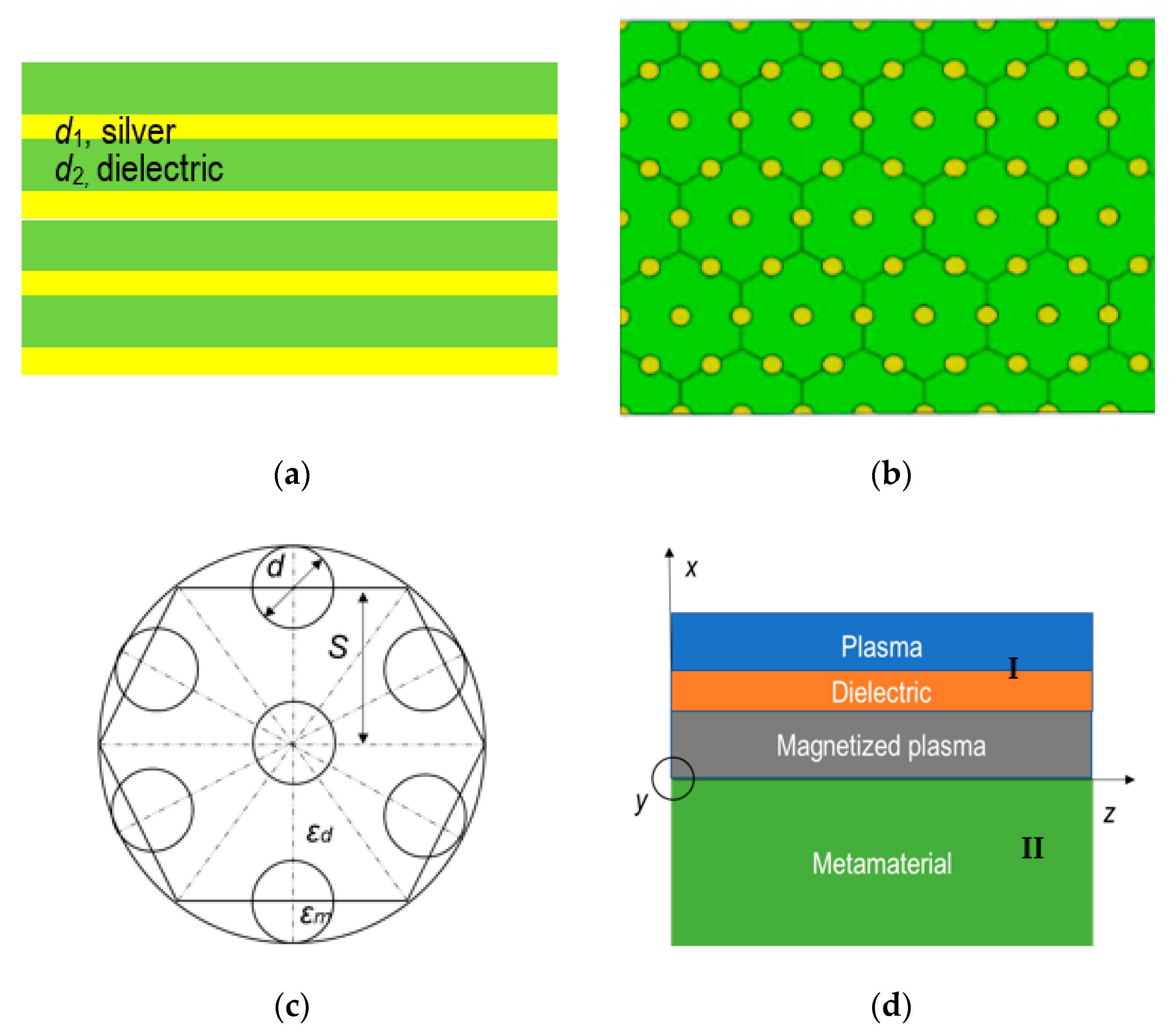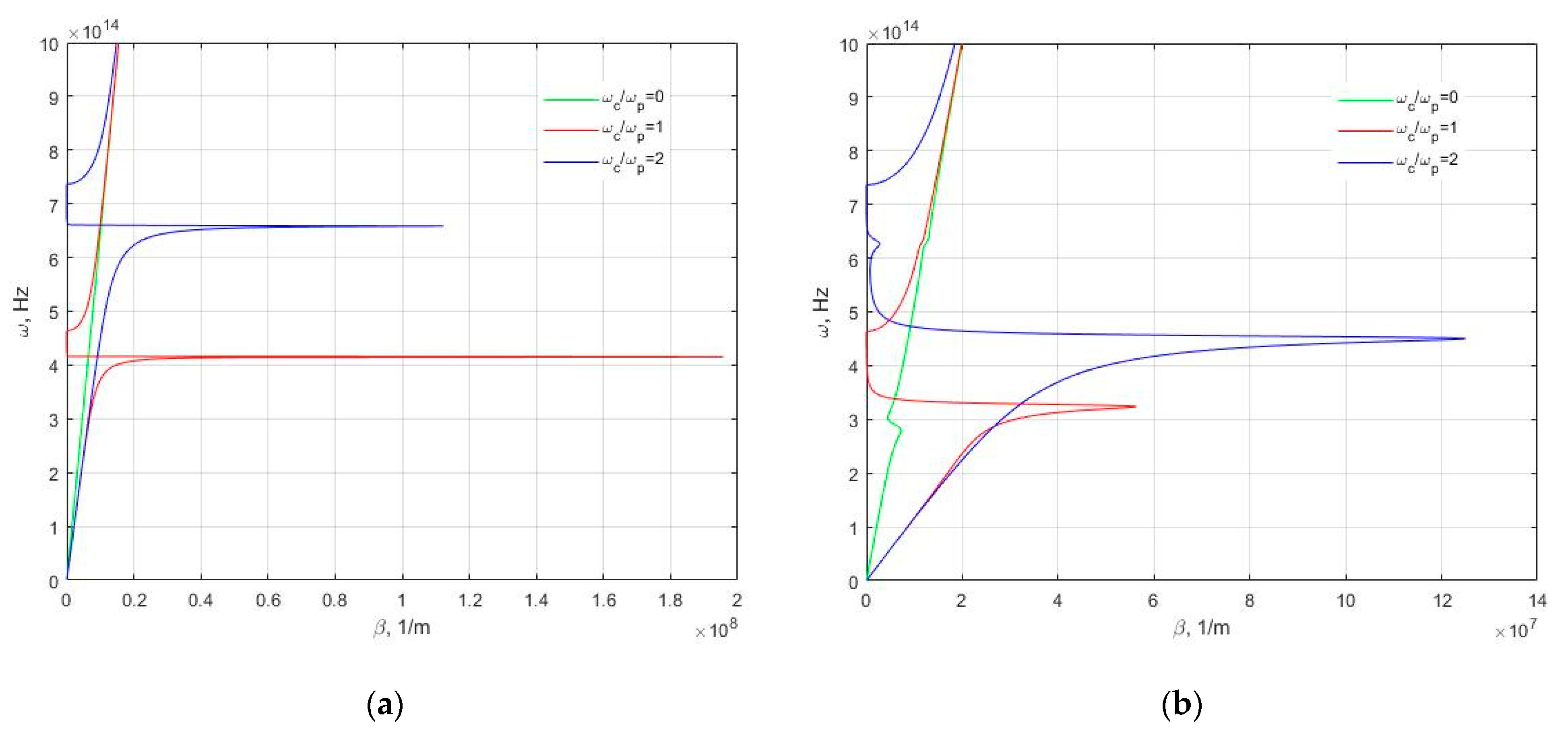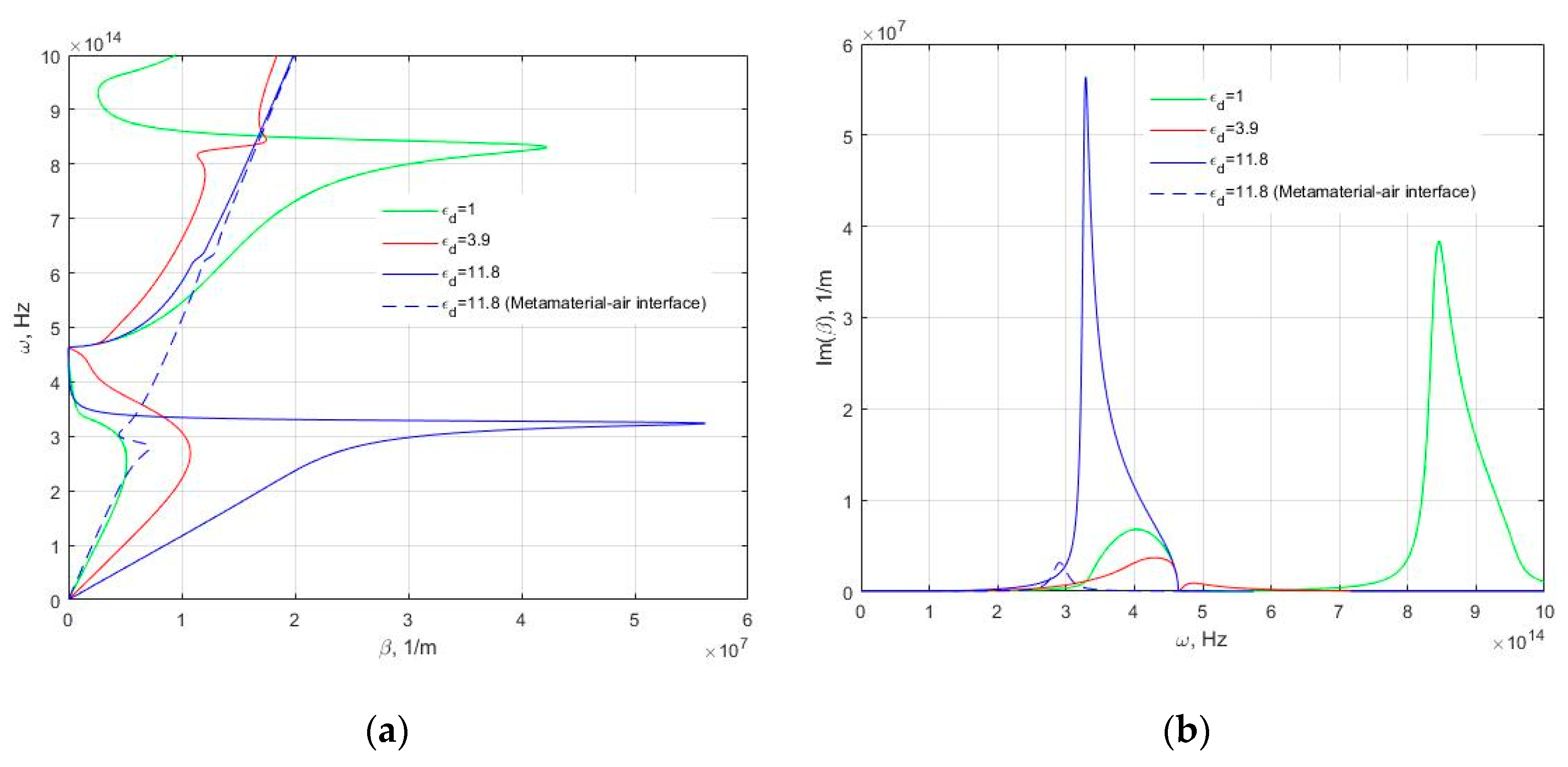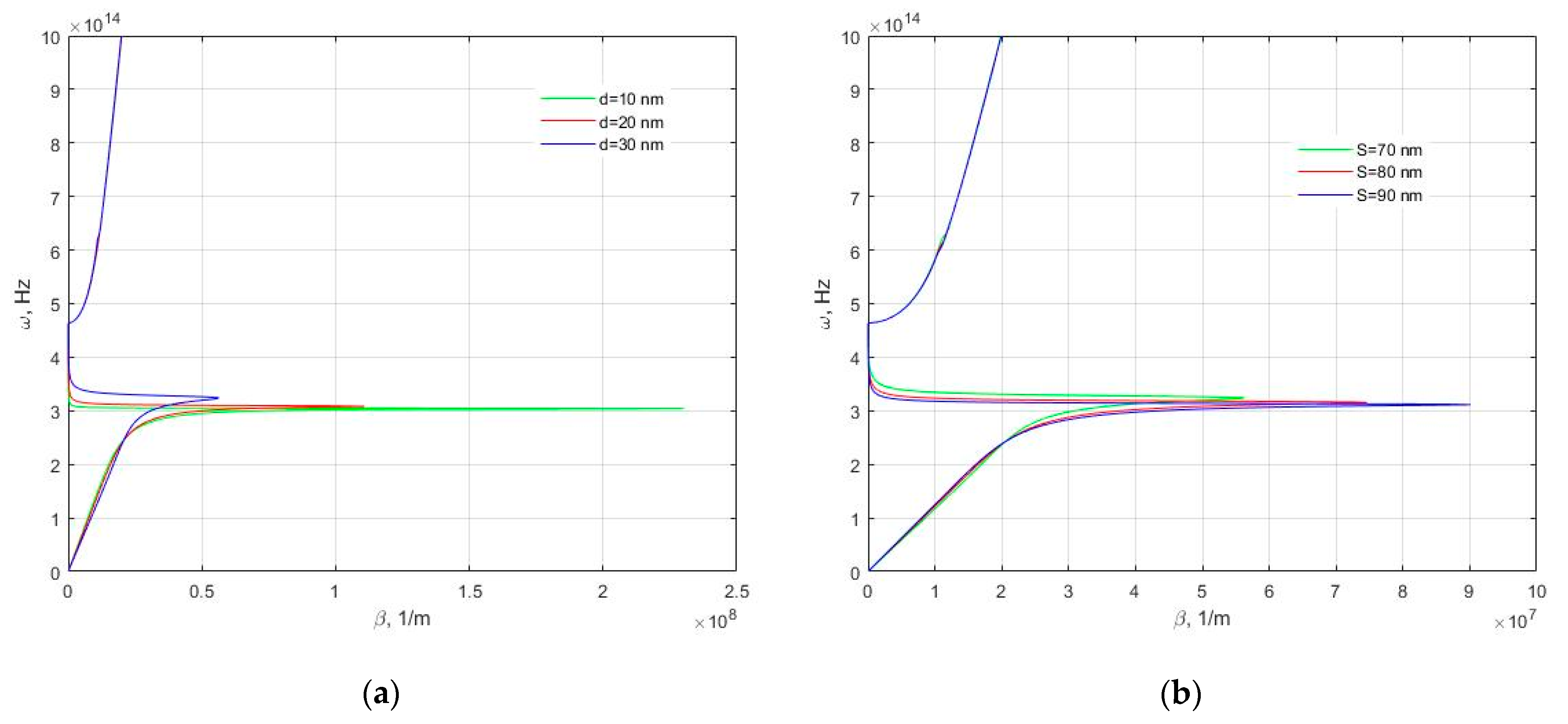1. Introduction
Surface plasmon polaritons (SPPs) are treated as the electromagnetic excitations occurring at the boundary separating two different substances. It is worthwhile mentioning that the real part of the dielectric function changes the signs on the interface. A conventional boundary separating a conducting and a dielectric medium was considered in [
1]. Recently, astonishing advancement has been obtained in the field of SPPs. In particular, many investigations implying SPPs in metamaterials and photonic crystals have been conducted because of the latter’s ability to dramatically tune SPPs’ features [
2].
Metamaterial research has attracted the attention of optical engineers and material scientists due to the variety of possible applications such as imaging [
3], cloaking [
4], sensing [
5], waveguiding [
6], and simulating space–time phenomena [
7]. Hyperbolic metamaterials (HMMs) are named because of the topology of the isofrequency surface. The linear dispersion and isotropic performance of propagating plasmons cause a spherical isofrequency surface. The exotic behavior of modes possessing large-magnitude wavevectors is considered as the most fascinating feature of such substrate. In vacuum, such large wavevector waves are evanescent with exponential decay.
The tunable properties of plasmas offering some peculiar advantages paved the way for the increasing interest in plasma photonic crystals and plasma composites. Plasmas possess major advantages in comparison with other conventional materials. Doing so, one may use the applied power supply for producing plasmas and adjusting the gas pressure or temperature of plasmas, aiming to engineer the dynamic shift in permittivity and calibrate the amplitude on the complex plane.
Herein, we consider an interface of a hyperbolic metamaterial and magnetic plasma, aiming to give rise to tunable properties including absorption enhancement. To attain the mentioned goal, we consider two different types of hyperbolic metamaterials, i.e., nanolayered metamaterials and nanowire metamaterials. The inclusion of a plasma layer opens wide avenues for investigations. The influences of the applied magnetic field, collision frequency of plasma, background material dielectric constant, and thickness on the dispersion relations of SPPs are explored and discussed. This paper is structured as follows. Firstly, we present the theoretical background, followed by the Results section.
2. Materials and Methods
The schematic illustrations of the metamaterial samples chosen for the considerations are demonstrated in
Figure 1. An obliquely incident EM wave of TM polarization was assumed. It is worthwhile mentioning that we are dealing with the propagation of waves at the interface separating the magnetized plasma layer and the metamaterial layer. A nanostructured metamaterial composed of exchanging sheets of metal and dielectric results in the required extreme anisotropy [
8] (
Figure 1a). Seeking for the valid homogenization approach, the thicknesses of the sheet should be smaller than the size of the operating wavelength. Metallic nanowires embedded in the dielectric material might be employed as an alternative approach seeking a hyperbolic behavior [
9] (
Figure 1b). Silver and gold are usually chosen as the possible metals that can be embedded in a nanoporous alumina template. Aiming to have a deep insight into the main characteristics of surface waves, we employed a Drude model for the metal (i.e., silver) characterization. In this relation, permittivity is calculated as
. The properties are found by fitting this permittivity function to a particular frequency range of the bulk material [
10]. It is concluded [
11] that for silver, the values of
,
, and
provide a reasonable fit.
The dielectric function of magnetic plasma is a permittivity tensor and is presented as follows:
where
ε1,
γ, and
α are the dielectric components perpendicular and parallel to the magnetization, and the magneto-optical component, respectively. Moreover, the magnetized plasma is expressed by the effective dielectric function as follows:
, where
,
, where
v is the collision frequency in plasma,
ωp is the bulk plasma frequency, and
is the cyclotron frequency [
12]. Herein,
B0 is the amplitude of the external magnetic field,
e is the absolute charge of the electron, and
me is the mass of the electron.
One may obtain a dispersion expression for the surface plasmons propagating at the boundary between two anisotropic media. It is worthwhile obtaining a single surface mode with the propagation constant [
13] by calculating the tangential components of the electric and magnetic fields at the interface:
where
β is the propagation constant,
k is the wave number in vacuum, and
,
are the frequency-dependent permittivities of the metamaterial, being a highly anisotropic medium, in the parallel and perpendicular directions to the wave propagation. It is important that the result (2) is valid only under the condition of surface confinement, which can be presented in the following form:
Following the effective medium approximation approach, one may calculate the effective permittivities of the nanowire metamaterial as follows:
Here,
ρ is the metal filling fraction ratio which is calculated as
3. Results and Discussion
Herein, we analytically investigate SPPs excited by a slit waveguide structure. The waveguide is formed by two semi-infinite plasma layers and a thin background dielectric layer, in which one plasma layer is in the presence of the external magnetic field and the other plasma layer is in the absence of a magnetic field. Two magnetic-optical effects are presented, the Faraday effect, and the Voigt effect if the plasma is involved with the external magnetic field. However, in this analysis, only the Voigt effect is taken into consideration. The plasma cannot be magnetized or influenced by the applied magnetic field under the transverse magnetic polarization case. Herein, we present a theoretical study by employing Equation (2) and consider the main characteristics of the SPPs. Equation (2) was solved with respect to β, aiming to obtain the results. The impact of the applied magnetic field, collision frequency, the dielectric constant, and the thickness of the dielectric layer embedded into the nanostructured metamaterial on the main characteristics of SPPs is studied. A magnetic field B0 is applied parallel to the interface separating two regions.
Figure 2 demonstrates the impact of the applied magnetic field on the dispersion diagrams of SPPs. The displayed dispersion curves tend to a stable frequency. The mentioned phenomenon takes place as the SPP modes propagate at the interface under study. The dramatic shift in the SPPs to the higher frequency range is observed, enhancing the external magnetic field. As it is seen in
Figure 2b, employment of the nanowire metamaterial media causes the exotic behavior of the dispersion curves. Between the regime of the bound and radiative modes, a frequency gap region with purely imaginary
β prohibiting propagation exists. As we can clearly observe in
Figure 2b, the case of
ωc/
ωp = 2 possesses some discrepancies in this specific region between bound and radiative modes with
β being not purely imaginary. Moreover, it can clearly be observed from
Figure 2b that
β is the complex number with Re(
β) ≠ 0 around
ω = 6.2 × 10
14 Hz. The presence of the real part of the propagation constant between regimes of the bound and radiative modes is treated as the exotic behavior of the proposed structure. Aiming to have a closer look at the nature of the propagating waves, we introduce electric field distributions. Doing so, the case of the nanowires is presented in
Figure 3.
We will further examine this case by engineering dielectric properties of the host media of the nanowire metamaterial along with the metamaterial geometry.
Figure 4 is plotted aiming to take into account the impact of the permittivity of the host material when the collision is considered for the plasma. One can conclude that the rise in the dielectric constant will result in the shift in the propagating plasmons to the lower-frequency range. The former phenomenon can be described by the variational principle [
14]. In other words, an increase in the dielectric constant ends with the shift in the modes to the lower-frequency range. It should be mentioned that for the instance of planar nanostructured hyperbolic metamaterials, one should expect the absorption enhancement to be a negligible effect because of the lack of any localized plasmons resulting in the field hotspots [
15]. Additionally, the high
k-modes cannot be excited by free space illumination and cannot have an impact on the absorption. As it is seen in
Figure 4b, the presence of the magnetic plasma significantly enhances the absorption.
Lastly, we introduce the numerical results of the effect of the geometry of the nanowires on the properties of SPPs, as shown in
Figure 5. It can be observed that geometrical changes do not have a dramatic impact on the dispersion curves.
4. Conclusions
To conclude, we studied the main characteristics of SPPs that can be excited in a metamaterial–magnetic plasma structure. Taking on board two different types of hyperbolic metamaterials, i.e., nanolayered and nanowire structures, we depicted both normal and absorbing dispersion relations of SPPs for TM polarization. We conclude that employment of magnetic plasmas into the structure under investigation gives rise to the tunable intriguing features of SPPs. It can be concluded that changes in the external magnetic field allow for the shift in the dispersion curves to the higher-frequency range. The former takes place by increasing the value of the
ωc/
ωp ratio. Moreover, SPPs at the boundary of nanowire composites possess an intriguing behavior. Between the regime of the bound and radiative modes, a frequency gap region with purely imaginary
β prohibiting propagation exists. The case of
ωc/
ωp = 2 possesses some discrepancies in this specific region with
β being not purely imaginary. Moreover, it can clearly be observed from
Figure 2b that
β is the complex number with Re(
β) ≠ 0 around
ω = 6.2 × 10
14 Hz. The presence of the real part of the propagation constant between regimes of the bound and radiative modes is treated as the exotic behavior of the proposed structure. It can be concluded that inclusion of magnetic plasma gives rise to the absorption enhancement that is pivotal and desirable for antenna design applications. Absorption enhancement can be controlled by varying the permittivity of the dielectric medium.
Author Contributions
Conceptualization, T.G. and E.R.; methodology, T.G.; software, T.G.; validation, T.G. and E.R.; formal analysis, T.G.; investigation, T.G.; resources, E.R.; data curation, E.R.; writing—original draft preparation, T.G. and E.R.; writing—review and editing, T.G. and E.R.; visualization, T.G.; supervision, E.R.; project administration, T.G. and E.R.; funding acquisition, T.G. and E.R. Both authors have read and agreed to the published version of the manuscript.
Funding
This project has received funding from the European Union’s Horizon 2020 research and innovation programme under the Marie Sklodowska Curie grant agreement No 713694 and from Engineering and Physical Sciences Research Council (EPSRC) (Grant No. EP/R024898/1). The work of E.U. Rafailov was partially funded by the Ministry of Science and Higher Education of the Russian Federation as part of World-class Research Center program: Advanced Digital Technologies (contract No. 075-15-2020-934 dated 17 November 2020).
Institutional Review Board Statement
Not applicable.
Informed Consent Statement
Not applicable.
Conflicts of Interest
The authors declare no conflict of interest.
References
- Zhang, J.; Zhang, L.; Xu, W. Surface plasmon polaritons: Physics and applications. J. Phys. D Appl. Phys. 2012, 45, 113001. [Google Scholar] [CrossRef]
- Gric, T.; Hess, O. Surface plasmon polaritons at the interface of two nanowire metamaterials. J. Opt. 2017, 19, 085101. [Google Scholar] [CrossRef]
- Jacob, Z.; Alekseyev, L.V.; Narimanov, E. Optical hyperlens: Far-field imaging beyond the diffraction limit. Opt. Express 2006, 14, 8247–8256. [Google Scholar] [CrossRef] [Green Version]
- Milton, G.W.; Nicorovici, N.-A.P. On the cloaking effects associated with anomalous localized resonance. Proc. R. Soc. A 2006, 462, 3027–3059. [Google Scholar] [CrossRef]
- Kabashin, A.; Evans, P.; Pastkovsky, S.; Hendren, W.; Wurtz, G.; Atkinson, R.; Pollard, R.; Podolskiy, V.; Zayats, A. Plasmonic nanorod metamaterials for biosensing. Nat. Mater. 2009, 8, 867–871. [Google Scholar] [CrossRef]
- Govyadinov, A.A.; Podolskiy, V.A. Metamaterial photonic funnels for subdiffraction light compression and propagation. Phys. Rev. B 2006, 73, 155108. [Google Scholar] [CrossRef] [Green Version]
- Smolyaninov, I.I.; Hung, Y.-J. Modeling of time with metamaterials. J. Opt. Soc. Am. B 2011, 28, 1591–1595. [Google Scholar] [CrossRef]
- Xiong, Y.; Liu, Z.; Sun, C.; Zhang, X. Two-dimensional imaging by far-field superlens at visible wavelengths. Nano Lett. 2007, 7, 3360–3365. [Google Scholar] [CrossRef] [PubMed]
- Kanungo, J.; Schilling, J. Experimental determination of the principal dielectric functions in silver nanowire metamaterials. Appl. Phys. Lett. 2010, 97, 021903. [Google Scholar] [CrossRef]
- Johnson, P.B.; Christy, R.W. Optical constants of the noble metals. Phys. Rev. B 1972, 6, 4370. [Google Scholar] [CrossRef]
- Oubre, C.; Nordlander, P. Finite-difference time-domain studies of the optical properties of nanoshell dimers. J. Phys. Chem. B 2005, 109, 10042–10051. [Google Scholar] [CrossRef] [PubMed]
- Wang, B.; Zhu, S.; Guo, B. Surface plasmon polaritons in plasma-dielectric-magnetic plasma structure. Plasma Sci. Technol. 2020, 22, 105002. [Google Scholar] [CrossRef]
- Iorsh, I.; Orlov, A.; Belov, P.; Kivshar, Y. Interface modes in nanostructured metal-dielectric metamaterials. Appl. Phys. Lett. 2011, 99, 151914. [Google Scholar] [CrossRef] [Green Version]
- Ustyantsev, M.A.; Marsal, L.F.; Ferre-Borrull, J.; Pallares, J. Effect of the dielectric background on dispersion characteristics of metallo-dielectric photonic crystals. Opt. Commun. 2006, 260, 583. [Google Scholar] [CrossRef]
- Tumkur, T.U.; Gu, L.; Kitur, J.K.; Narimanov, E.E.; Noginov, M.A. Control of absorption with hyperbolic metamaterials. Appl. Phys. Lett. 2012, 100, 161103. [Google Scholar] [CrossRef]
| Publisher’s Note: MDPI stays neutral with regard to jurisdictional claims in published maps and institutional affiliations. |
© 2021 by the authors. Licensee MDPI, Basel, Switzerland. This article is an open access article distributed under the terms and conditions of the Creative Commons Attribution (CC BY) license (https://creativecommons.org/licenses/by/4.0/).











